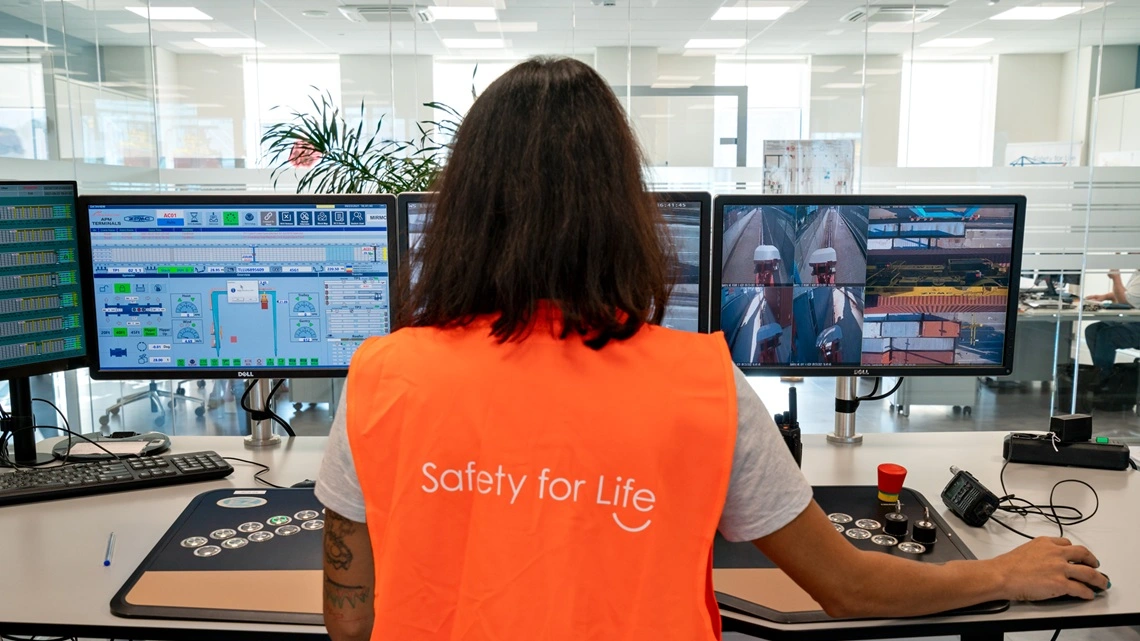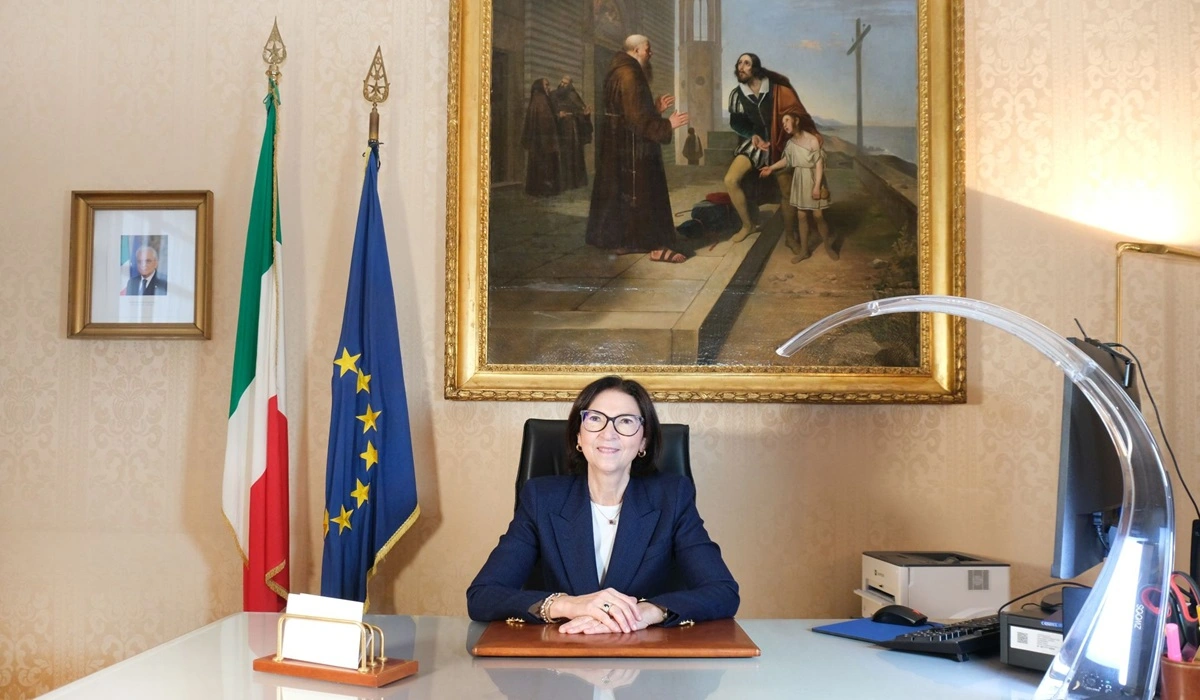
A port has always symbolised protection, refuge, a safe haven on land after voyages across stormy seas. It is no coincidence that the expression “to reach port” is used metaphorically to indicate a successful outcome or the successful completion of an endeavour. However, the nature of an advanced, multifunctional port system like those of Genoa and Savona—which employ thousands of people, day and night—is also complex and potentially hazardous if safety and prevention are not always prioritised. Within the ports, very different activities coexist, from cargo handling to passenger transit, from shipbuilding to large-scale infrastructure projects with yards active for years. Ensuring safety in such an environment where activities can interfere, creating risks requires more than merely adhering to rules and regulations. It requires a “civilisation pact,” a shift in mindset where safety becomes the responsibility of all: institutions, companies, and workers alike. This is the starting point for this special report, which, through in-depth articles, authoritative interviews, and firsthand accounts, explores how the ports of Genoa and Savona serve as laboratories for fostering a shared safety culture.
- Guardians of safety: inspectors in action
- Prevention is a team effort. PSAL (Prevention and Workplace Safety Unit of ASL Genoa) Director Mercurio emphasises dialogue to achieve concrete solutions
- Prefect Cinzia Torraco: “Safety? A measure of civilisation in advanced economies” – Interview
- Safety First: 20 years of training for a new port safety culture
- Safety First: 20 years of training for a new port safety culture
- Safety and environmental protection: the Coast Guard at the forefront in the Ports of Savona and Vado
- Fire and Rescue Service: synergy and 24/7 readiness safeguarding the ports
- From rules to responsibility: the new model of port safety
Guardians of safety: inspectors in action
The AdSP (Port Authority) Inspectors’ Corps represents the main safeguard for occupational health and safety in the ports of Genoa and Savona. Through inspections, targeted checks, and comprehensive interventions, inspectors constantly monitor compliance with regulations to protect workers’ health and ensure safe working environments. They liaise with company technical staff and workers’ representatives and collaborate with other institutions, requesting their intervention on matters within their remit.
The main activities of the AdSP operational units include safety inspections related to port operations and services, as well as shipyard activities. Particular attention is given to verifying the proper handling of hazardous materials, a task of extreme delicacy and central importance for the protection of both operators and the environment. The Inspectors’ Corps is also engaged in monitoring port traffic and internal road safety, checking the condition of infrastructure and working closely with the Port Security Department to manage traffic. Proper maintenance and management of roadways is crucial not only to prevent accidents but also to ensure rapid and effective emergency response.
To ensure infrastructure remains safe and efficient, inspectors patrol concession areas where insufficient maintenance could put workers at risk. In cases of non-compliance, they notify the AdSP Land Management Department, which ensures that concessionaires carry out the required interventions within set deadlines. Inspections conclude with on-site verification that the works have been properly completed. This collaborative model has created a virtuous cycle: in 2024, the number of reported maintenance deficiencies dropped significantly, reflecting a heightened sense of responsibility among concessionaires for the upkeep of port facilities.
Each inspection is documented by inspectors in reports, photographs and supporting attachments, which are promptly forwarded to the relevant authorities, including external bodies such as ASL (Local Health Authority) and INAIL (Italian National Institute for Insurance against Workplace Accidents) when occupational safety issues arise, to allow timely follow-up and the implementation of corrective measures to ensure a safe working environment.
To give some figures, in 2024 personnel at the ports of Genoa and Savona carried out nearly 1,200 inspections and over 2,800 interventions in response to reports from the port community, often in coordination with other authorities responsible for occupational safety. The increase in inspections surpassed the 15% national target established for the Presidents of the Port Authorities. For 2025, inspectors are required to make a further effort by increasing inspections by 20%, thereby consolidating the progress made.
The second consecutive confirmation of port occupational safety as a national priority highlights the importance of the issue and the value of the work undertaken by the AdSP of the Western Ligurian Sea, which has long developed and professionalised its Inspectorate, demonstrating foresight in recognising its strategic role.
Equally fundamental in building a shared and participatory safety culture is the liaison role played by inspectors with company-level and site-level Workers’ Safety Representatives (RLSA and RLSS, respectively). Their daily presence on site provides timely and detailed feedback on potential risks, giving a more accurate picture than that obtained from a single inspection and contributing to the prevention of accidents and injuries.
Collaboration between inspectors, Workers’ Safety Representatives (RLS), and companies facilitates proactive measures to ensure workplace safety through regular reviews to assess current practices and identify areas for improvement. These findings emerged during interviews conducted at one of the terminals of Genoa’s Sampierdarena commercial port during a scheduled inspection conducted by inspectors.
Finally, ongoing dialogue between inspectors and the RLS across all port terminals enables best practices from each operator to be identified and shared with the entire port community, fostering a coordinated, shared approach to safety. To further strengthen the synergy between the Inspectors’ Corps and workers’ representatives, over the past two years AdSP has launched a process to enhance the roles and resources of RLSS across the port sector.
This integrated model ensures continuous, focused oversight, promoting a safe working environment and safeguarding the health of all port personnel.
Prevention is a team effort. PSAL Director Mercurio calls for dialogue on concrete solutions
The Health and Safety Committee is a cornerstone of shared governance in the prevention and protection of the health of port workers in Genoa and Savona. Chaired by the Port Authority, the Committee brings together the Prevention and Workplace Safety (PSAL) unit of the Local Health Authority (ASL), along with representatives of both workers and employers. Depending on the matters under consideration, it is often joined by experts from the Harbour Master’s Office, ARPAL (the Regional Environmental Protection Agency), the Fire Brigade, the Emergency Medical Service (118), and other bodies, all working in a spirit of full institutional cooperation. This synergy enables a crucial issue such as safety to be addressed with expertise, a shared vision and a strong commitment to the continuous improvement of working conditions.
It is within this framework that the PSAL unit of ASL Genoa carries out its daily work, as illustrated by Eng. Gabriele Mercurio, Head of the Workplace Prevention and Safety Department. “PSAL, together with the Labour Inspectorate, is the supervisory authority designated to ensure compliance with health and safety legislation, particularly within the port sector,” explains Mercurio. “We carry out preventive inspections to avert risk situations, but we also investigate accidents and occupational diseases when they unfortunately occur”. Close cooperation with the Port Authority is a major advantage, as Mercurio notes, since “it maintains an inspection team with a strong local presence. Port inspectors carry out a broad range of checks and, thanks to the prior coordination on areas to be monitored, PSAL can intervene in a more focused and thorough manner, thereby enhancing the overall effectiveness of the supervisory system”.
Institutional oversight is essential to ensure compliance with regulations, but when it comes to prevention, everyone has a role to play. “Safety,” emphasises Director Mercurio, “is not only the responsibility of institutions, but also of social partners, trade unions, companies and employee representatives. The Port Health and Safety Committee thus serves as a forum where diverse perspectives are brought together to reach shared, practical solutions – translating dialogue into tangible outcomes for everyone’s safety”.
Indeed, the Committee’s added value lies in engaging the entire port cluster by disseminating guidelines and initiatives arising from consultations, sharing best practices and new models introduced by individual terminals, and fostering a network of communication and participation that keeps operational standards and procedures firmly in focus – particularly when new requirements or critical situations arise.
One example of this is the development of emergency response sheets for the ports of Savona and Vado, as described in the video interview on the subject.
These operational documents are handed directly to emergency responders by security personnel stationed at the port gates, who are on duty 24 hours a day, seven days a week. The sheets contain all the information necessary for a rapid and effective response: they provide precise directions to the terminal—a crucial factor in the complex port environment—outline the activities carried out there, highlight the presence of any flammable or hazardous materials, and indicate the location of firefighting equipment on site. Being able to know immediately where to intervene and what situation to expect significantly reduces response times and enhances safety for all personnel.
Emergency response sheets represent just one of the many measures implemented by the Port Authority. The complexity, dynamism and unique characteristics of each port within the Western Ligurian Sea Port Authority require solutions that are continually innovative and specifically tailored. In the Genoa and Pra’ basins, for example, innovations introduced in 2024 by the multidisciplinary technical committee enabled the updating of previous emergency procedures. In addition to installing dedicated road signage for emergency services, modern geolocation systems were implemented at the entrance gates of individual terminals, allowing for the rapid and precise identification of the location requiring intervention.
Another result of the collaboration between institutions, workers and companies through the Health and Safety Committee was the adoption, in July 2025, of a protocol for integrating occupational health and safety across the industrial sector. The agreement, strongly promoted by the Prefect of Genoa, Cinzia Torraco, introduces a series of concrete measures, including the establishment of on-site health and safety representatives (RLS) with extended responsibilities covering subcontracted companies, structured training programmes, joint inspections and continuous monitoring, systematic data collection on accidents and near misses—including subcontractors—and the direct involvement of the Port Authority Inspectorate.
These topics—and other protocols aimed at enhancing the protection of those who work daily in port areas—were discussed with Prefect Cinzia Torraco, who granted us an exclusive interview for this special feature on safety.
Prefect Cinzia Torraco: “Safety? A measure of civilisation in advanced economies” – The Interview

Over the past few months, at the initiative of the Prefecture of Genoa and with the involvement of the Port Authority, social partners, as well as other relevant public institutions and trade associations, two important protocols have been signed aimed at strengthening workplace health and safety protections. The first concerns the renewal of the protocol on the protection of workers in cases of high thermal stress, a condition that has become increasingly frequent during the summer months. The second, focused on the port sector, reinforces preventive measures to ensure workplace safety within the ship repair area of the Port of Genoa. What are your thoughts on this experience?
In recent months, the Prefecture has actively promoted the signing of several Memoranda of Understanding, including those mentioned above, both relating to workplace safety. There is no doubt that institutions at every level are called upon to place workplace safety at the very centre of their activities. Indeed, I am firmly convinced that a genuine culture of legality and safety must begin, above all, in schools! Educating people about safety goes beyond mere compliance with regulations; it involves creating the conditions in which safety becomes a fundamental, non‑negotiable and enduring value — a true measure of civilisation in advanced economies. I am therefore very pleased with the work that has recently resulted in the renewal of the Microclimate Agreement, which introduces significant protections for workers aimed at preventing potential instances of thermal stress, as well as the signing of the Protocol on Safety in the Ship Repair Sector. This latter agreement raises the level of vigilance in a sector marked by considerable complexity — not least due to the extensive network of subcontracting — and is, at the same time, of great importance to the city’s economy. The latter agreement, which I strongly advocated during the discussions held at the Prefecture in the aftermath of the tragic accidents that occurred in the Port last February and March, stands as a model of effective cooperation between institutions, businesses and trade unions, grounded in the shared awareness that workplace safety is both a fundamental right and a collective responsibility.
Collaboration and cohesion among institutions in creating a safer and more equitable working environment are essential to strengthening protections and ensuring equal rights for all workers within the same sector. To what extent can this shared commitment between the Port Authority and the Prefecture help to instil a culture of safety among port companies and their workers?
I firmly believe that inter-institutional cooperation is an indispensable modus operandi for addressing major challenges — among them, workplace safety. Synergy among public bodies is the key instrument to achieve the tangible result of raising safety standards. Synergy among institutions is the key instrument for achieving tangible improvements in safety standards. In his role as the Government’s representative in the territory, the Prefect needs to collect data, information and insights from the relevant institutional actors, trade unions, and employers’ associations representing the various economic sectors. In this regard, I am pleased to emphasise the highly productive cooperation with the Port Authority in developing the agreements under discussion, particularly the Protocol on Ship Repairs, in which the Authority played a crucial role in coordinating the input from all signatory parties.
While not directly related to workplace safety, it is important to highlight the signing of a third protocol aimed at combating labour exploitation and irregular employment. How might this agreement also affect workplace safety, particularly in the port sector?
Promoting legality in the workplace inherently contributes to improving safety standards. This is the goal pursued by the Protocol on combating labour exploitation and illegal employment — a genuine “Pact of Civility”, the result of a process of consultation, collaboration, and shared responsibility. It could also be seen as a pact of shared responsibility that reinforces the role of the State while supporting and mobilising the local network. The document represents not only a practical instrument but also a genuine territorial pact, designed to monitor, prevent, and counter all forms of workplace illegality, which, implicitly and through training, contributes to the enhancement of safety standards. This applies to all sectors, including the port sector, particularly in ship repairs, which, as I have already emphasised, is marked by a network of subcontracting and a significant proportion of foreign workers who require additional training and guidance.
In conclusion, we encourage you to look ahead to the near future. Which of the commitments undertaken by the Prefecture on workplace safety will involve the Port Authority and the wider port cluster?
The Prefecture is committed to continuing the virtuous path initiated with the signing of the agreements under discussion. Both the Microclimate Agreement and the Protocol on Labour Exploitation provide for the monitoring of the commitments set out in the respective documents, with the signatories naturally involved in the process. I would also like to explore an agreement that enhances worker protections in the event of extreme weather conditions, whether due to excessively low temperatures or heavy rainfall. Undoubtedly, such an agreement would have a significant impact in the port sector, where the operations of companies working within the port are often affected by prevailing weather conditions.
Safety First: 20 years of training for a new culture of safety in the port
In addition to its activities in monitoring and managing safety across the port area, and the work of the Hygiene and Safety Committee, the Port Authority promotes training initiatives designed to strengthen a culture of prevention among all port operators. A central role in this context is played by the Safety First courses, which offer supplementary training alongside the mandatory courses required by current regulations.
The Safety First courses are primarily targeted at new employees in the commercial sector of the Port of Genoa and were established in the early 2000s under an agreement between social partners and the relevant authorities. Each course runs for 16 hours and includes instructors from a variety of sectors, including the Port Authority, port chemists, occupational health physicians, and other specialists. The aim is to provide an overview of the key occupational health and safety risks in the port environment, with particular emphasis on the complex interactions between the various activities carried out at the terminals.
Topics covered include error management, internal port traffic safety, the identification and classification of hazardous materials, and best operational practices in shared working environments. The courses do not concentrate on the specific operations of individual terminals, but instead focus on understanding the interactions and interrelationships between various port activities, fostering a holistic and proactive approach to risk management.
Since 2000, the Safety First courses have delivered approximately 140 editions, exclusively dedicated to the commercial sector of the Port of Genoa. The Port Authority is currently working to extend these courses to the ship repair sector, adapting the content to address the specific requirements of shipbuilding and naval maintenance operations.
Safety and environmental protection: the Coast Guard at the forefront in the Ports of Savona and Vado
The sea is a precious resource, yet also a fragile ecosystem that demands constant care and attention. In the ports of Savona and Vado Ligure, environmental protection forms an integral part of operational safety: safeguarding the sea means ensuring safe and sustainable working conditions for everyone who operates daily across the Ports of Genoa.
Within this framework, the Italian Coast Guard plays a central role in monitoring and coordination, working tirelessly to prevent and combat marine pollution, oversee waste management, and supervise operations that may have an environmental impact — all in close and continuous cooperation with the Western Ligurian Sea Port Authority.
Among the Coast Guard’s key responsibilities is the prevention and control of oil pollution, an area where proactive measures and emergency response are closely intertwined.
Every vessel arriving in port, whether Italian or foreign-flagged, is subject to inspections by Coast Guard officers to verify compliance with international conventions and Italian legislation on the protection of the marine environment.
In the event of a pollution incident, the Coast Guard takes command of emergency response operations, mobilising all competent authorities to contain and remove pollutants as swiftly as possible. This rapid response capability, combined with constant preventive action, enables port operators to work in a safe environment while minimising the risk of pollution affecting the coastline.
Another cornerstone of environmental safety is the monitoring and management of port waste cycles. The collaboration between the Port Authority and the Coast Guard ensures a structured and efficient procedure: the Authority designates the operators responsible for waste collection and disposal, while the Harbour Master’s Office regulates, through its own ordinances, the procedures for waste delivery by merchant vessels — both those moored alongside and those anchored in the roadstead.
Waste from ships is also collected by dedicated service vessels, ensuring the correct management of materials even for vessels that, for operational reasons, cannot enter the port.
This model maintains high standards of environmental protection at every stage of the process, preventing the accumulation and dispersion of harmful substances. Oversight extends beyond large merchant vessels: marinas and recreational boating are also part of this shared responsibility approach.
Every marina and landing area is equipped with an eco-island, enabling recreational boaters to dispose of their waste properly — including special waste such as batteries, oils, and filters. These facilities are essential for protecting the marine environment, promoting responsible behaviour, and preventing improper or illegal disposal of materials.
The protection of the marine and coastal environment is an integral component of the overall safety of the port range.
Through a combined approach of monitoring, prevention, and training, the Coast Guard and the Port Authority work side by side to ensure ports that are increasingly safe, efficient, and environmentally sustainable.
Fire and Rescue Service: synergy and 24/7 readiness safeguarding the ports
In the ports of the Western Ligurian Sea – from Genoa and Pra’ to Savona and Vado Ligure – the safety of port operations relies on readiness, technical expertise, and strong institutional coordination. The Fire and Rescue Service plays a strategic role, providing fire prevention and firefighting, technical rescue, and support for maritime search and rescue activities, in close cooperation with the Harbour Master’s Office. “The Fire and Rescue Service,” explains Fulvio Borsano, Deputy Commander of Savona, “operates both on land and at sea, fully integrated within the rescue network that covers the entire port range”.
Proximity of response is a decisive factor. In the ports of Savona and Vado Ligure, for example, the Port Fire Station ensures immediate emergency intervention directly within the port area, reducing response times to the most sensitive terminals and quays. This shared operational approach extends throughout the port network, where rapid response and inter-agency cooperation are at the heart of safety management.
Emergency scenarios reflect the complexity of the port environment, where fires and accidents may occur in highly diverse settings – from quays and cargo-handling facilities with varying flammability risks to ship decks, crane structures and the confined vertical spaces of silos. Ongoing infrastructure works add further operational challenges. In all contexts, rescue operations must be swift and effective to minimise damage and promptly restore safe conditions.
Regular emergency drills – such as those recently conducted in Vado Ligure – are designed to test exactly these scenarios, simulating engine-room fires or the recovery of injured personnel in hard-to-reach locations. These exercises involve coordinated participation from the Harbour Master’s Office, Red Cross, tug operators, and port personnel.
The Fire and Rescue Service’s operational fleet reflects the variety of potential incidents, including firefighting and rescue vessels – from fast-response craft to displacement boats – capable of operating both within port waters and in the immediate vicinity of ships. “Prevention,” Borsano emphasises, “is not a one-off action but a daily commitment: joint training, procedural reviews and constant updates to emergency plans ensure full alignment between the Fire and Rescue Service, the Maritime Authority and terminal operators”.
At sea, coordination forms part of the national SAR (Search and Rescue) framework managed by the Coast Guard: local Coastal Guard Units initiate the first response actions, with possible escalation to Maritime Rescue Sub-Centres (MRSCs) or the Italian Maritime Rescue Coordination Centre (IMRCC). Within this framework, the Fire and Rescue Service contributes personnel and resources, working in close synergy with port assets and tugboats. “Synergy between all agencies involved is essential,” reiterates Borsano, also highlighting the valuable contribution of terminal operators, who provide staff and equipment to accelerate safety operations.
Round-the-clock coverage is ensured through a network of fire stations located across the different ports, following response protocols that prioritise the nearest available unit. “The main risks,” Borsano concludes, “remain fire and rescue operations, yet the low incidence of serious emergencies demonstrates the effectiveness of a system built on training, planning and cooperation”. This balance makes the Fire and Rescue Service a vital pillar for the protection of workers and the operational resilience of the entire port range.
From rules to responsibility: the new model of port safety
Safety at port terminals goes beyond simply following rules and procedures; it is a culture, a way of thinking and acting that involves every individual, every day. Transitioning from a view of safety as a formal obligation — a duty imposed to avoid penalties — to a widespread awareness that protection and prevention are a shared responsibility represents a true shift in mindset. In this new approach, everyone plays an active role: daily actions, even the smallest, contribute to making the workplace safer for all.
Safety at the ports stems from a sense of shared responsibility, uniting people under a single objective: protecting themselves and those working alongside them. This principle is expressed daily through concrete actions, mutual awareness, and care for the collective well-being.
“We work in teams of around 25 people,” explains Veronica Spotorno, Terminal Supervisor at Vado Gateway, “and it is vital that every operator not only protects themselves but also looks out for others”.
In her role, she coordinates around one hundred operators across four daily quay-side shifts — a task that demands constant focus, balance, and attentive leadership. “Attention to physical and mental well-being has a significant impact on safety,” Spotorno notes. “Operators need the best possible conditions to perform their roles effectively”.
This philosophy blends organisation with human awareness: allowing longer or more frequent breaks when necessary is an investment in both work quality and team safety. “When operators are in good physical and mental condition, they perform more effectively, with greater clarity and attention,” adds the Supervisor.
The terminal operates complex machinery — Ship-to-Shore (STS) cranes for container handling, quayside straddle carriers, and Rail-Mounted Gantry (RMG) cranes, remotely operated — alongside diverse professional roles: port company staff, refrigeration technicians, and maintenance personnel. It is a dynamic environment where every activity is interconnected, and each decision can immediately impact overall safety.
“My responsibility,” continues Veronica Spotorno, “is to observe each operator, assess their physical and mental state, and intervene when necessary. This requires time and attention, but it makes a real difference”.
This vigilant, empathetic, and professional approach embodies the “civic pact” underpinning the safety culture at the Ports of Genoa and Savona: the understanding that protecting each individual is a shared responsibility, to be exercised daily, together.





